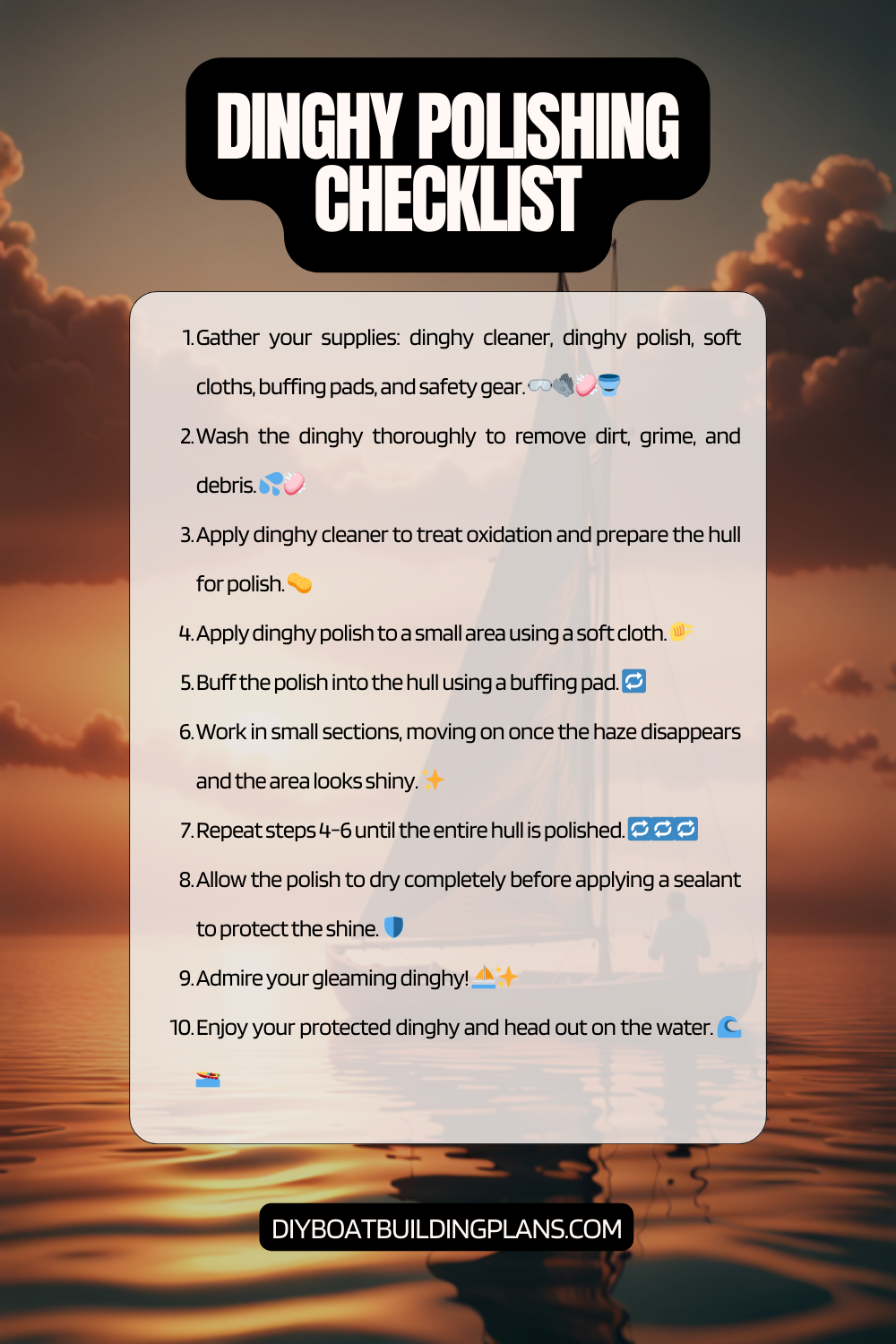Overview of Dinghy Polishing Tips
Dinghy polishing is the process of restoring and maintaining the appearance of your dinghy. A dinghy is a small boat typically used for transportation or recreation, and just like any other watercraft, it is exposed to various environmental factors that can cause damage and wear over time. Dinghy polishing involves using specialized products and techniques to remove stains, scratches, and oxidation, and to restore the shine and luster of the boat’s surface.
Maintaining the appearance of your dinghy is not just about aesthetics; it also plays a crucial role in preserving the boat’s value and longevity. A well-maintained dinghy not only looks more appealing but also performs better on the water. Regular polishing helps protect the boat’s surface from harmful UV rays, saltwater corrosion, and other environmental factors that can cause fading, discoloration, and deterioration. By investing time and effort into dinghy polishing, you can ensure that your boat remains in top condition for years to come.
Key Takeaways
- Dinghy polishing is important to maintain the appearance and longevity of your boat.
- Choosing the right polish and preparing your dinghy properly are crucial for achieving a good result.
- Different types of dinghies require different polishing techniques, and hard-to-reach areas can be challenging.
- Stubborn stains and scratches can be removed with the right products and techniques.
- Regular maintenance is key to keeping your dinghy looking shiny and new, and safety should always be a top priority when polishing.

Importance of Dinghy Polishing
Regular dinghy polishing offers a multitude of benefits that go beyond just enhancing its appearance. One of the primary advantages is protection against environmental factors. Dinghies are constantly exposed to harsh conditions such as sunlight, saltwater, dirt, and debris. Over time, these elements can cause damage to the boat’s surface, leading to fading, discoloration, and even structural issues. By regularly polishing your dinghy, you create a protective barrier that shields it from these harmful elements.
In addition to protection, regular polishing also helps maintain the resale value of your dinghy. A well-maintained boat with a glossy finish is more likely to attract potential buyers and command a higher price compared to a dinghy that shows signs of neglect. Polishing not only restores the shine but also removes minor scratches and imperfections, making your dinghy look newer and more appealing.
Choosing the Right Polish for Your Dinghy
When it comes to choosing the right polish for your dinghy, there are several factors to consider. Firstly, you need to determine the type of material your dinghy is made of. Different polishes are designed for specific materials such as fiberglass, inflatable PVC, or wooden surfaces. Using the wrong polish can lead to ineffective results or even damage the boat’s surface.
Secondly, consider the condition of your dinghy. If it has heavy oxidation or deep scratches, you may need a more aggressive polish that can effectively remove these imperfections. On the other hand, if your dinghy only requires light maintenance and touch-ups, a milder polish would be sufficient.
Lastly, take into account the level of gloss or shine you desire. Some polishes offer a high-gloss finish, while others provide a more subtle shine. Consider your personal preference and the overall look you want to achieve for your dinghy.
Preparing Your Dinghy for Polishing
| Task | Frequency | Time Required |
| Clean Dinghy | Before Polishing | 30 minutes |
| Remove Stains | As Needed | Varies |
| Apply Polish | Once a Year | 2-3 hours |
| Buff Dinghy | After Applying Polish | 1-2 hours |
Before you begin the polishing process, it is essential to properly prepare your dinghy. Start by thoroughly cleaning and drying the boat’s surface. Remove any dirt, grime, or salt residue using a mild detergent and a soft brush or sponge. Rinse off the cleaning solution with fresh water and allow the dinghy to dry completely.
If there is any existing wax or polish on the surface, it needs to be removed before applying a new coat. Use a wax remover or a specialized polish remover to strip away any old products. This step ensures that the new polish adheres properly to the surface and provides optimal results.
Taking the time to prepare your dinghy adequately sets the foundation for a successful polishing process and ensures that the new polish can effectively bond with the boat’s surface.
Polishing Techniques for Different Types of Dinghies
The polishing techniques for different types of dinghies may vary depending on the material they are made of. Here are some guidelines for polishing fiberglass, inflatable, and wooden dinghies:
For fiberglass dinghies, start by applying a small amount of polish to a clean, dry microfiber cloth or applicator pad. Work the polish into the surface using circular motions, applying moderate pressure. Continue polishing until the desired shine is achieved. For deeper scratches or oxidation, you may need to use a compound or a more aggressive polish. Once the polishing is complete, wipe off any excess polish with a clean cloth.
Inflatable dinghies require a different approach due to their PVC or Hypalon material. Use a specialized inflatable boat cleaner to remove any dirt or stains from the surface. After cleaning, apply a UV protectant specifically designed for inflatable boats to prevent fading and damage from sunlight. Avoid using abrasive polishes or compounds on inflatable dinghies, as they can cause damage to the delicate material.
Wooden dinghies require careful handling to avoid damaging the wood. Start by sanding the surface lightly with fine-grit sandpaper to remove any imperfections or roughness. Apply a marine-grade wood polish using a soft cloth or brush, following the wood grain. Allow the polish to penetrate the wood and then buff it with a clean cloth to achieve a smooth and glossy finish.
Tips for Polishing Hard-to-Reach Areas
Polishing hard-to-reach areas of your dinghy can be challenging but not impossible. Here are some tips to help you tackle those tricky spots:
1. Use the right tools: Invest in specialized polishing tools such as small applicator pads, foam brushes, or even toothbrushes to reach narrow crevices and corners.
2. Be patient and careful: Take your time when working on hard-to-reach areas to ensure thorough coverage and avoid accidental damage. Apply gentle pressure and use small, controlled motions to achieve the desired results.
Remember, the effort you put into polishing these difficult areas will contribute to the overall appearance and longevity of your dinghy.
How to Remove Stubborn Stains and Scratches
Stubborn stains and scratches can be a headache for dinghy owners, but with the right products and techniques, they can be effectively addressed. Here’s how to tackle them:
1. Identify the type of stain or scratch: Different stains and scratches require different approaches. For example, waterline stains can be removed with a specialized stain remover, while rust stains may require a rust remover. Scratches can be categorized as either surface-level or deep. Surface-level scratches can often be buffed out with a mild abrasive polish, while deep scratches may require more extensive repair.
2. Use the appropriate products and techniques: Once you have identified the type of stain or scratch, choose the appropriate product for removal. Follow the instructions provided by the manufacturer and apply the product using the recommended technique. For example, some stains may require soaking or scrubbing, while others may need to be treated with a chemical solution.
By using the right products and techniques, you can effectively remove stubborn stains and scratches, restoring your dinghy’s appearance to its former glory.
Maintaining the Shine on Your Dinghy
After polishing your dinghy, it is crucial to maintain its shine to ensure long-lasting results. Regular cleaning and maintenance play a significant role in preserving the polished finish. Here are some tips for maintaining your dinghy’s shine:
1. Regular cleaning: Wash your dinghy with fresh water after each use to remove saltwater, dirt, and debris that can cause damage over time. Use a mild detergent and a soft brush or sponge to gently clean the surface.
2. Avoid harsh chemicals: When cleaning your dinghy, avoid using harsh chemicals or abrasive cleaners that can strip away the polish or damage the boat’s surface. Stick to mild, boat-friendly cleaning products.
3. Apply a protective coating: After cleaning, consider applying a protective coating or wax to further enhance the shine and provide an additional layer of protection against UV rays and environmental factors. Follow the manufacturer’s instructions for application and reapplication.
By incorporating these maintenance practices into your routine, you can extend the life of your dinghy’s polished finish and keep it looking its best.
Common Mistakes to Avoid When Polishing Your Dinghy
While dinghy polishing can be a straightforward process, there are some common mistakes that you should avoid to achieve optimal results:
1. Over-polishing: Excessive polishing can lead to a buildup of product on the surface, resulting in a hazy or streaky appearance. Follow the manufacturer’s instructions regarding the amount of polish to use and the recommended frequency of application.
2. Using the wrong products: Using the wrong polish or cleaning products can damage your dinghy’s surface or yield unsatisfactory results. Always choose products specifically designed for your dinghy’s material and follow the manufacturer’s recommendations.
3. Not following instructions: Each polish or cleaning product may have specific instructions for application, drying time, and removal. Failure to follow these instructions can lead to subpar results or even damage to your dinghy. Take the time to read and understand the instructions before starting the polishing process.
By avoiding these common mistakes, you can ensure that your dinghy polishing efforts yield the desired outcome without any unnecessary setbacks.
Download over 500 Boat Plans. Click on the link below.
-->Click Here<--
Polishing Safety Tips
When engaging in dinghy polishing, it is essential to prioritize safety to prevent accidents or injuries. Here are some safety tips to keep in mind:
1. Wear protective gear: Always wear gloves and safety goggles when handling polishes, cleaners, or any other chemicals. This protects your skin and eyes from potential irritation or harm.
2. Be cautious around water and electricity: When polishing your dinghy, be mindful of the proximity to water and electrical outlets. Avoid using electrical tools or equipment near water to prevent the risk of electric shock.
3. Work in a well-ventilated area: Polishing products can emit fumes that may be harmful if inhaled. Ensure that you are working in a well-ventilated area or use a respirator mask if necessary.
Prioritizing safety during the polishing process ensures that you can enjoy the benefits of a beautifully polished dinghy without any unnecessary risks.
Dinghy Polishing Checklist

Conclusion – Dinghy Polishing Tips
In conclusion, dinghy polishing is an essential aspect of maintaining the appearance and value of your boat. Regular polishing not only enhances the aesthetics but also protects your dinghy from environmental factors that can cause damage and deterioration. By choosing the right polish, properly preparing your dinghy, and using the appropriate techniques, you can achieve a glossy finish that will make your boat stand out on the water.
Remember to maintain the shine by regularly cleaning your dinghy and applying a protective coating. Avoid common mistakes such as over-polishing or using the wrong products, and prioritize safety throughout the polishing process. By following these tips and guidelines, you can ensure that your dinghy remains in top condition, providing you with years of enjoyment on the water.
FAQs – Dinghy Polishing Tips
What is dinghy polishing?
Dinghy polishing is the process of cleaning and shining the exterior of a dinghy boat to maintain its appearance and protect it from damage caused by exposure to the elements.
Why is dinghy polishing important?
Dinghy polishing is important because it helps to protect the boat from damage caused by exposure to the sun, saltwater, and other environmental factors. It also helps to maintain the boat’s appearance and can increase its resale value.
What materials are needed for dinghy polishing?
Materials needed for dinghy polishing include a polishing compound, a buffing pad, a microfiber cloth, and a boat wax or sealant.
How often should I polish my dinghy?
The frequency of dinghy polishing depends on how often the boat is used and the conditions it is exposed to. As a general rule, it is recommended to polish the boat at least once a year, but more frequent polishing may be necessary for boats that are used frequently or exposed to harsh conditions.
What is the best way to apply polishing compound?
The best way to apply polishing compound is to use a buffing pad attached to a power drill or polisher. Apply a small amount of compound to the pad and work it into the surface of the boat in a circular motion, applying light pressure.
What is the best way to apply boat wax or sealant?
The best way to apply boat wax or sealant is to use a clean microfiber cloth. Apply a small amount of wax or sealant to the cloth and work it into the surface of the boat in a circular motion, applying light pressure. Allow the wax or sealant to dry completely before buffing it off with a clean microfiber cloth.



